China’s fluid humanoid stuns — but US still rules robot brains
XPeng’s latest robot IRON, amazes audiences with its lifelike movements, yet globally, advanced AI and chips are keeping the US in command of humanoid intelligence. Lianhe Zaobao’s China Desk dives into the issue.
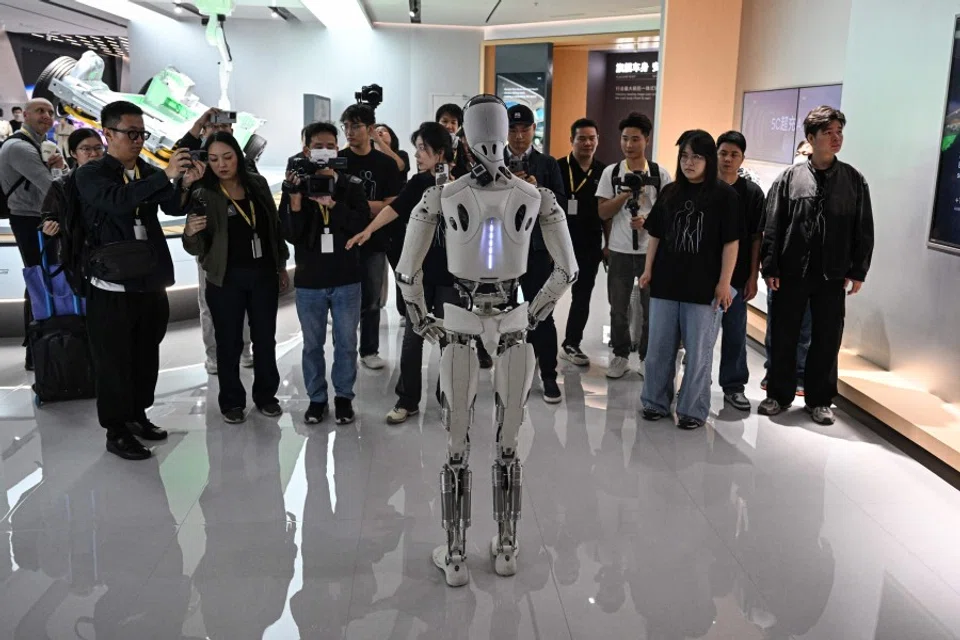
Chinese EV maker XPeng wowed audiences with its latest humanoid robot, IRON, at a recent launch. Compared with last year’s somewhat stiffer first-generation model, the upgraded version released on 5 November features a female physique and a much more fluid, coordinated gait.
Despite slight mechanical pauses, its walking posture is now close to that of a real human. One internet user marvelled: “If it walked beside me, one might not be able to tell which is the robot.”
However, the lifelike performance has also drawn scepticism. Some online users scrutinised details such as the head contour and ear shape in the video and suspected that the robot might actually be a human in disguise. Others questioned whether the video could have been generated through artificial intelligence (AI).
In response to the controversy, XPeng chairman He Xiaopeng released a one-take video on 6 November showing IRON’s entire catwalk process. In the video, the development team even unzips the back of the robot to reveal its internal mechanical structure, proving that it is indeed a real robot.
At the launch event that evening, they staged a live “unboxing” — staff cut open the outer shell of IRON’s leg, exposing the internal metal joints and wiring, before letting it walk off on its own.
“Many simply can’t believe that such a powerful technology could come from a Chinese company. Our mental biases are like a mountain.” — He Xiaopeng, Chairman, XPeng
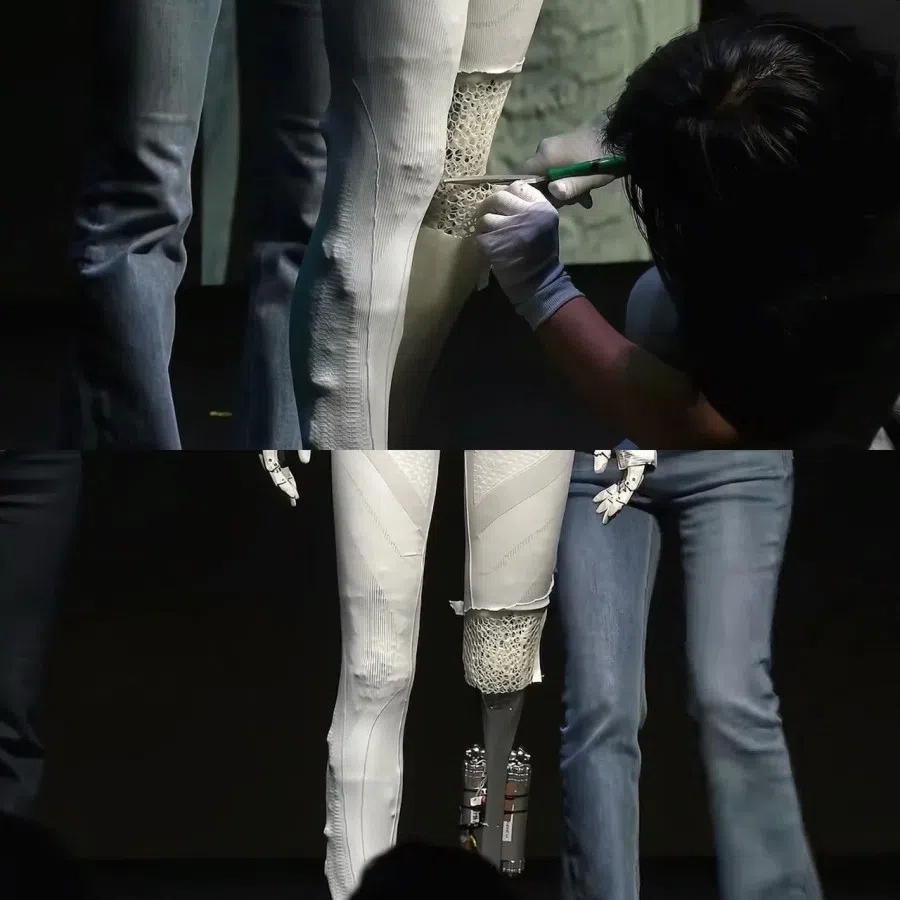
Interestingly, after IRON’s appearance, XPeng’s share price briefly fell by around 2%. But once the official clarification video was released, the stock rebounded by about 1.4%, showing how market sentiment fluctuated along with the debate over whether the robot was real.
He Xiaopeng admitted that when IRON’s zipper was opened, revealing its internal structure: “To be honest, I felt a bit heartbroken. If IRON had come from an overseas company, perhaps there wouldn’t have been so much scepticism — people would be applauding and excited. Many simply can’t believe that such a powerful technology could come from a Chinese company. Our mental biases are like a mountain.”
XPeng’s breakthrough has also drawn international attention. Elon Musk, CEO of Tesla — the American tech giant also developing humanoid robots — liked the videos and commented: “Tesla and China companies will dominate the market. I have great respect for China competition. So many smart, hardworking people in China.”
So what exactly makes this robot impressive?
... unlike EVs, these chips must simultaneously control the precise movements of 82 joints, process visual and language inputs in real time, and maintain bipedal balance, adding to computational demands.

According to tech media reports, IRON’s core lies in XPeng’s self-developed first-generation “large model for the physical world”, which can break down complex instructions into multi-step tasks, perform path planning, and autonomously adapt in dynamic environments without human intervention.
To meet the needs of high-intensity computation, IRON is equipped with three self-developed Turing AI chips from XPeng. Its overall computing power is comparable to the neural-processing level of high-end autonomous-driving systems. But unlike EVs, these chips must simultaneously control the precise movements of 82 joints, process visual and language inputs in real time, and maintain bipedal balance, adding to computational demands.
Supported by its advanced algorithms and onboard computing power, IRON’s dexterous mechanical hands, bionic spine and specially designed forefoot allow it to bend to pick up objects and walk with smooth, human-like fluidity.
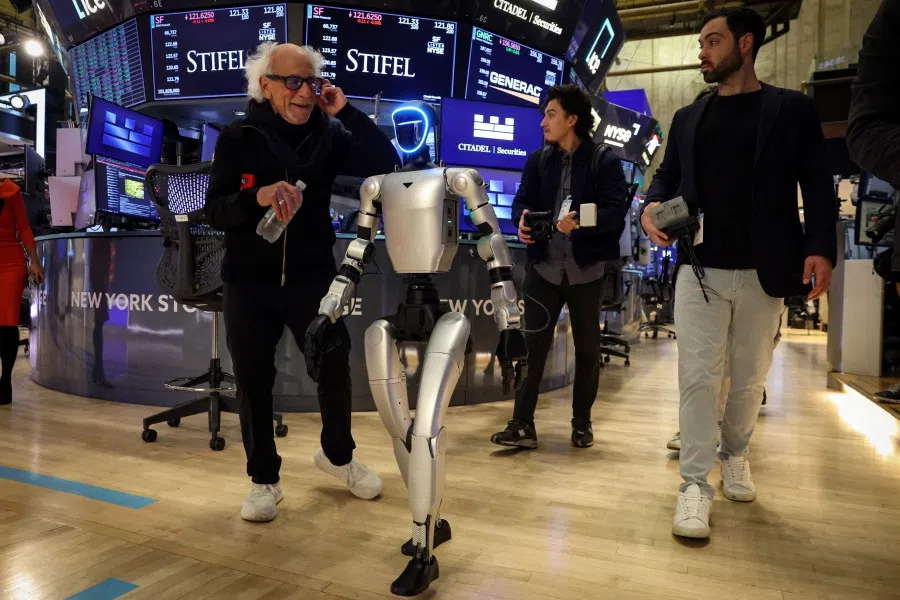
He Xiaopeng noted that the core advantage of the “highly humanoid” approach lies in data collection. Since the vast majority of global environments and tools are designed around humans, only humanoid robots can effectively collect and learn human behavioural data in such environments. Put simply: the more human-like the robot, the better it can adapt to the human world.
For businesses, humanoid robots represent a labour force that does not need vacations or pay raises; for households, they may become the “ultimate home appliance”.
Development of humanoid robots
Although the humanoid-robot field is still in its early stages and still some distance away from truly entering household service scenarios, its potential market is extremely attractive.
For businesses, humanoid robots represent a labour force that does not need vacations or pay raises; for households, they may become the “ultimate home appliance” — after all, who wouldn’t want a robot that can do laundry, tidy up and even load the dishwasher?
Today, humanoid robots have become one of the hottest tracks in the global tech industry, drawing major companies and startups from around the world, including Tesla, BMW and Hyundai Motor.
Among them, Tesla is developing its humanoid robot named Optimus. Musk plans to mass-produce about 5,000 units this year and says these robots will be “genuinely useful” and take on “useful work” inside Tesla’s factories.
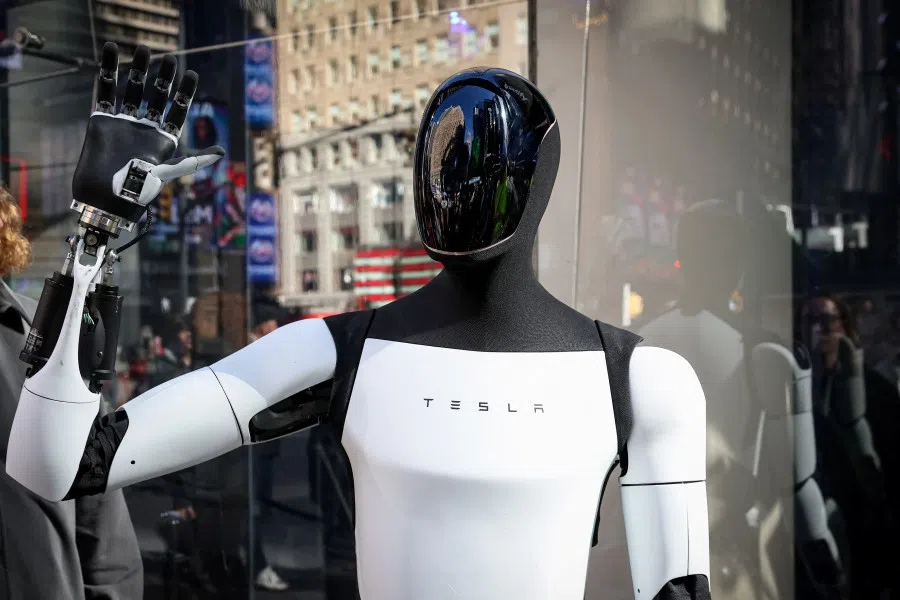
Meanwhile, Chinese companies are also accelerating their push in the sector, with major players including automotive brands such as BYD, Xiaomi and Chery. The 2025 Morgan Stanley Humanoid 100 list includes 35 Chinese companies, and among the 22 companies capable of full-system robot manufacturing, nine are from China, demonstrating strong competitive potential.
China’s rapid growth in humanoid robotics is supported by government policy. In 2023, the Ministry of Industry and Information Technology issued guidelines aiming to build an innovation ecosystem by 2025, advance core technologies, promote industrial applications and foster globally competitive companies — goals experts say are already seeing significant progress.
... the main reason both Chinese state-backed institutions and private companies are pivoting toward humanoid robots is the looming labour force crisis caused by demographic shifts.
Morgan Stanley’s research also shows that China continues to exhibit the most obvious momentum in humanoid robotics. Chinese startups, supported by a comprehensive supply-chain system, diverse application scenarios, and robust national policies, are rapidly narrowing their gap with global leaders.
Analysts point out that the main reason both Chinese state-backed institutions and private companies are pivoting toward humanoid robots is the looming labour force crisis caused by demographic shifts. With an accelerating ageing population and younger generations reluctant to take factory jobs, China’s manufacturing sector faces a severe labour shortage. As early as 2021, officials predicted that by 2025, the shortfall in manufacturing workers would approach 30 million — a trend expected to continue worsening.

The Economist Intelligence Unit forecasts that China’s working-age population will shrink to around 645 million by 2045, a sharp drop from its 2013 peak of 794 million, and will account for less than half of the national population. For an economy heavily dependent on exports, this trend could jeopardise China’s official target of doubling its 2020 per-capita GDP by 2035.
Following a development trajectory similar to that of smartphones and electric vehicles, China’s humanoid robotics industry may experience explosive growth as component costs decline and policy support strengthens — creating a vast “blue ocean” market full of potential.
The thing is, major technical bottlenecks remain in creating a truly “general-purpose robot”.
Risks amid the US-China tech rivalry
In an ideal scenario, robots should be able to adapt to changing environments, execute a variety of human tasks, and interact with people in real time. In other words, they would not simply be passive “assistants”, but autonomous “co-workers” capable of learning and acting proactively.
But the reality is that today’s mature generative-AI models are still primarily trained on text, making it difficult for them to meet the complex demands of robotics — such as vision, spatial perception and motion control.
Currently, Chinese companies hold about 63% of the global humanoid robotics supply chain, particularly excelling in hardware production — from actuators and sensors to lithium-ion batteries. In this sense, China’s robots are physically strong, but they are still mentally lacking. At robot boxing tournaments and marathon events held in the first half of this year, participating robots were fully controlled by humans. While impressive to watch, the events exposed limitations in underlying models and motion-control algorithms.
... tech giants such as Microsoft, Nvidia and Google continue to provide the core computing power and algorithmic support that serve as the “brains” for most of the world’s humanoid robots.
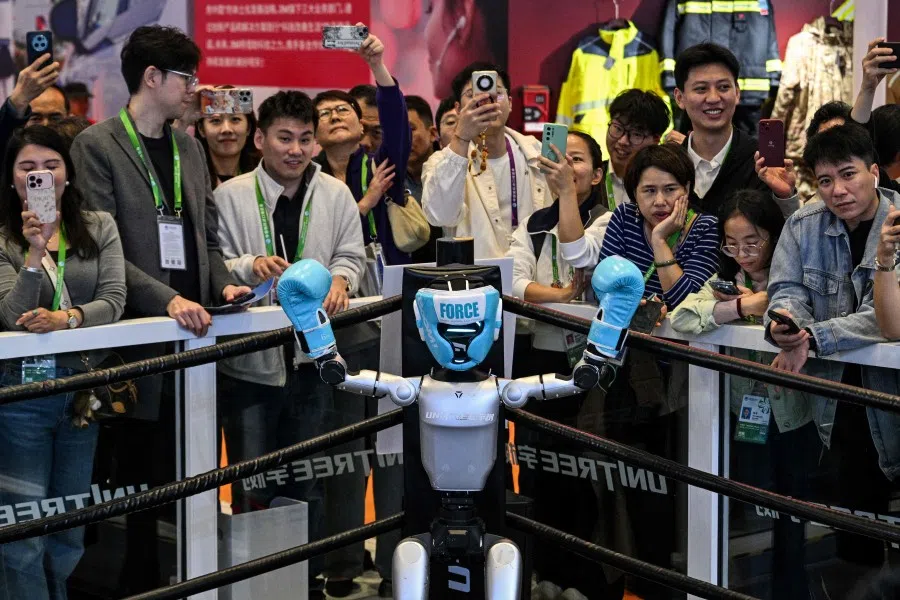
What truly determines a robot’s level of intelligence is the software and chip capabilities behind it — and in this domain, the US still holds the dominant position. A Morgan Stanley report released in February noted that tech giants such as Microsoft, Nvidia and Google continue to provide the core computing power and algorithmic support that serve as the “brains” for most of the world’s humanoid robots. In comparison, Chinese companies may possess strong manufacturing advantages, but they remain constrained in the areas of high-end chips and advanced AI models.
The ongoing US-China tech war has further widened this gap. With the US prohibiting Nvidia from exporting high-performance AI chips such as the Blackwell series to China, Chinese companies now face increasingly tight restrictions on accessing cutting-edge computing resources.
Yet investor enthusiasm has not cooled. Data shows that the global humanoid robotics market could surpass US$5 trillion by 2050, with the global humanoid-robot population expected to exceed 1 billion units, and China’s market alone possibly accounting for around 300 million. Coupled with strong policy support and national-level strategic planning, the growth momentum of China’s humanoid robotics industry remains robust.
However, as more and more companies rush into the field, what was once viewed as a “blue ocean” is gradually becoming a fiercely competitive “red ocean”. XPeng’s elegantly walking robot has injected fresh excitement into the race, but behind the spotlight, uncertainties in competition, technology and supply chains continue to simmer beneath the surface.
This article was first published in Lianhe Zaobao as “当机器人变得太像人”.





